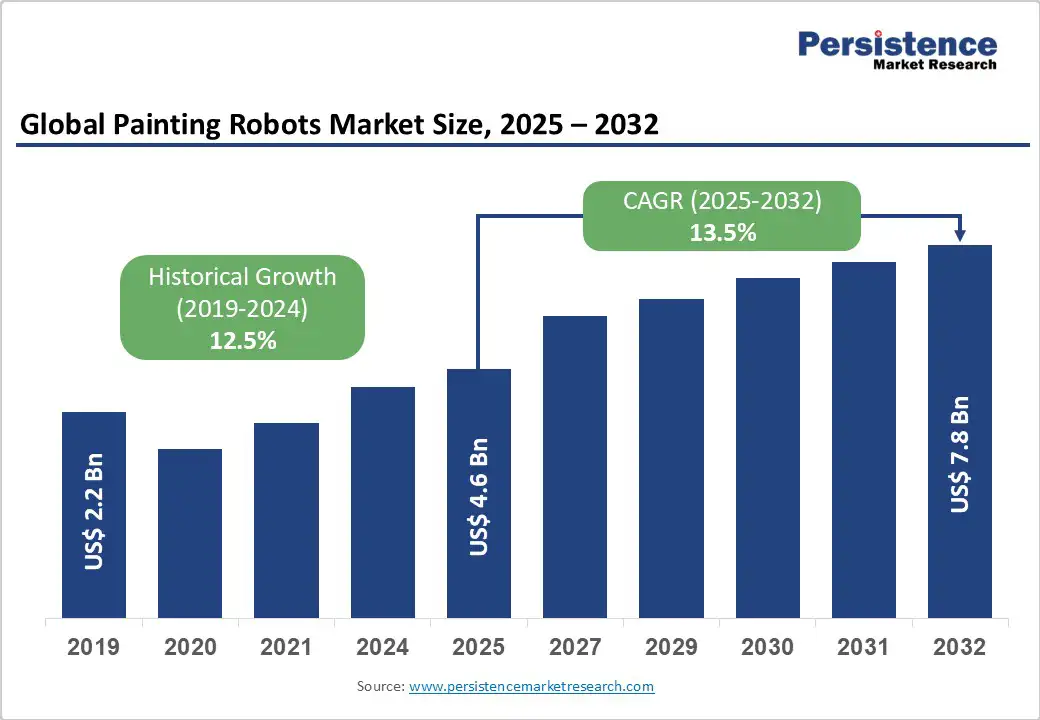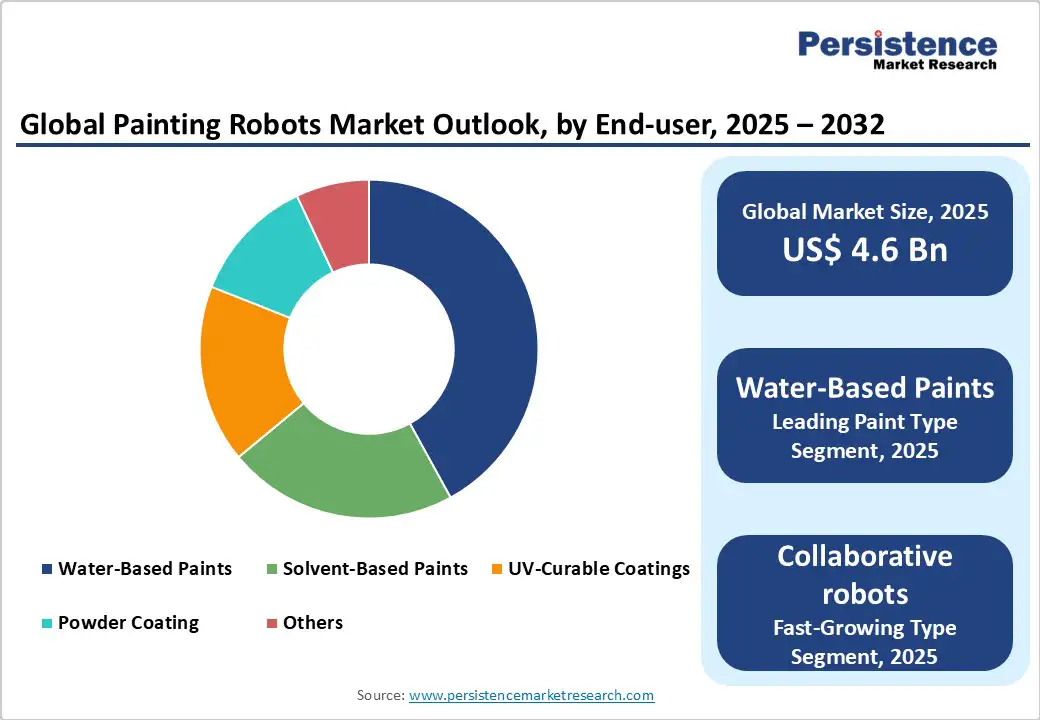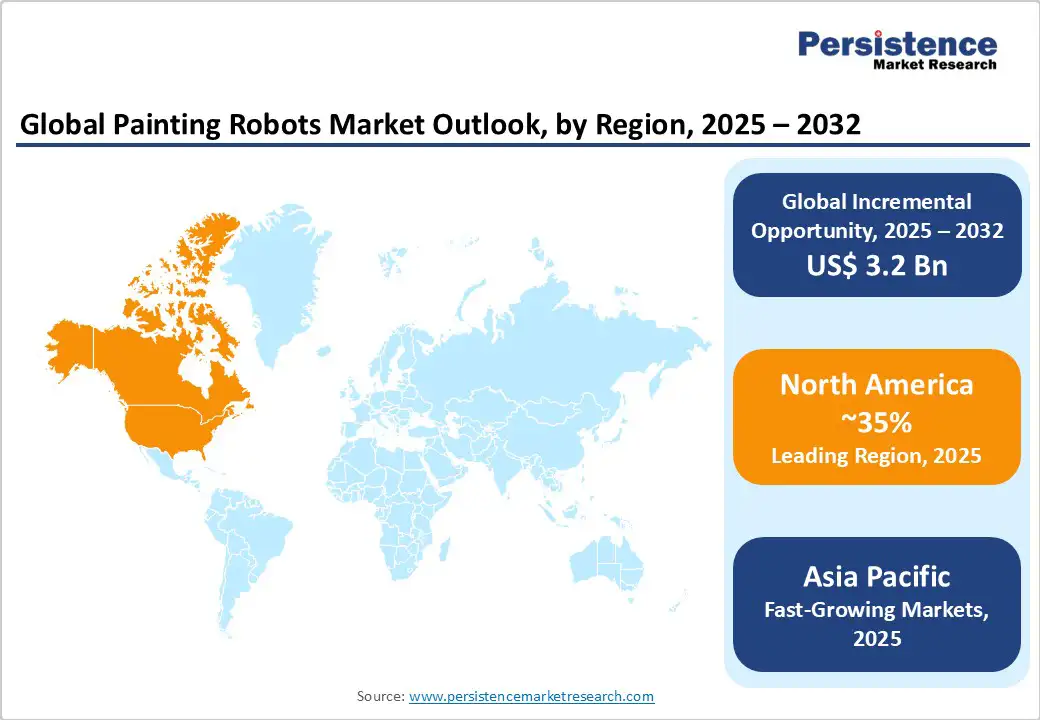ID: PMRREP35749| 186 Pages | 17 Oct 2025 | Format: PDF, Excel, PPT* | Industrial Automation

The global painting robots market size is likely to be valued at US$4.6 billion in 2025, and is projected to reach US$7.8 billion by 2032, growing at a CAGR of 13.5% during the forecast period 2025 - 2032.
This remarkable growth trajectory reflects the increasing adoption of automation across manufacturing sectors, driven by the urgent need for enhanced production efficiency, consistent quality control, and improved workplace safety.
The market's expansion is primarily fueled by stringent environmental regulations mandating reduced emissions of volatile organic compounds (VOCs), rising labor costs, and the continuous advancement of Industry 4.0 technologies that enable smarter, more connected manufacturing processes.
| Key Insights | Details |
|---|---|
| Painting Robots Market Size (2025E) | US$4.6 Bn |
| Market Value Forecast (2032F) | US$7.8 Bn |
| Projected Growth CAGR (2025 - 2032) | 13.5% |
| Historical Market Growth (2019-2024) | 12.5% |

The global shift toward industrial automation represents the most significant driver propelling the painting robots market forward. Manufacturing facilities worldwide are experiencing acute labor shortages, particularly skilled painters capable of delivering consistent, high-quality finishes.
According to recent industry data, major players have reported an increase in demand for their painting robot systems in 2024, primarily driven by automotive manufacturers seeking to maintain production schedules despite workforce constraints.
The automotive industry, which accounts for approximately 45% of global painting robot installations, has witnessed companies such as Audi implementing 28 new Dürr AG robots in their Ingolstadt facility for the production of the Q6 e-tron series.
This automation trend extends beyond automotive to aerospace, electronics, and furniture manufacturing, where companies are investing in robotic solutions to achieve 24/7 production capabilities while maintaining consistent quality standards that human operators cannot match.
Environmental compliance has emerged as a critical catalyst for the adoption of painting robots, with manufacturers facing increasingly strict VOC emission regulations globally. The European Union (EU)'s VOC Solvents Emissions Directive and similar regulations in North America and the Asia Pacific are compelling companies to adopt automated painting systems that minimize waste and optimize material usage.
Robotic painting systems can reduce paint consumption through improved transfer efficiency and precise application control, resulting in significantly lower VOC emissions compared to manual processes. For example, Universal Robots and Yaskawa Electric Corporation have developed collaborative painting robots specifically designed to handle water-based and low-VOC coatings, supporting manufacturers' transition to environmentally compliant processes.
The substantial upfront investment required for robotic painting systems remains a significant barrier, particularly for small and medium-sized enterprises (SMEs). Complete painting robot installations, including peripheral equipment, safety systems, and integration costs, can range from US$150,000 to over US$500,000 per unit, depending on application complexity and automation level.
This high initial cost is compounded by the technical expertise required for system integration, programming, and ongoing maintenance. A large number of SMEs lack the necessary technical personnel or financial resources to justify such investments, especially when considering the additional costs of employee training and potential production downtime during implementation.
The complexity of integrating robotic systems with existing manufacturing infrastructure further amplifies these challenges, often requiring extensive facility modifications and process reengineering that can extend payback periods beyond acceptable thresholds for smaller manufacturers.
Moreover, the sophisticated nature of modern painting robots, particularly those incorporating AI and machine learning (ML) capabilities, demands highly skilled technicians for operation, programming, and maintenance.
The shortage of qualified robotics engineers and technicians represents a significant operational constraint, with many companies struggling to find personnel capable of optimizing robotic painting processes. KUKA AG and Kawasaki Heavy Industries, for instance, have reported that inadequate technical support can lead to suboptimal system performance, increased downtime, and reduced return on investment.
These skills gaps are particularly evident in emerging markets where technical education infrastructure may be limited, creating dependency on external support services that increase operational costs and extend response times for critical maintenance issues.
The convergence of Internet of Things (IoT), artificial intelligence, and advanced analytics presents unprecedented opportunities for painting robot manufacturers and users. Industry 4.0 initiatives are driving the demand for intelligent painting systems that can optimize processes in real-time, enable predictive maintenance, and integrate seamlessly with Manufacturing Execution Systems (MES).
ABB's latest painting robots incorporate advanced sensors and AI algorithms that enable autonomous quality control, automatic parameter adjustment based on environmental conditions, and predictive component replacement scheduling.
The global Industry 4.0 market, valued at over $130 billion in 2024, is creating substantial demand for connected painting robots that provide comprehensive process data, enabling manufacturers to optimize material usage, reduce waste, and achieve consistent quality metrics.
Companies investing in smart painting systems can achieve significant improvements in OEE while reducing operational costs through data-driven decision-making and automated process adjustments.
Water-based paints are poised to dominate the painting robots market, with an estimated 42% revenue share, reflecting the global shift toward environmentally compliant coating solutions. This segment's leadership is driven by increasingly stringent VOC emission regulations and corporate sustainability initiatives that prioritize low-emission coating technologies.
Water-based paints offer significant advantages in robotic applications, including reduced fire hazards, lower toxicity levels, and compatibility with standard robotic equipment without requiring specialized explosion-proof configurations. Major automotive manufacturers, including Toyota, Volkswagen, and General Motors, have mandated water-based paint systems across their global production facilities, maintaining consistent demand for compatible robotic application equipment.
Articulated robots are expected to command the largest market share, approximately 38%, in 2025, establishing themselves as the preferred solution for complex painting applications that require maximum flexibility and precision. These six-axis and seven-axis robots excel in automotive body painting, aerospace component coating, and intricate furniture finishing applications where multiple angles and orientations are essential for complete coverage.
FANUC Corporation's articulated paint robots, including the P-50iB series, demonstrate superior maneuverability in confined spaces while maintaining consistent spray patterns across complex geometries. Continuous technological improvements, including enhanced servo motor precision, advanced path planning software, and integrated collision avoidance systems reinforce the segment's dominance.
The automotive industry is slated to maintain its position as the leading application segment, accounting for approximately 45% of global painting robot installations in 2025. This dominance reflects the automotive sector's early adoption of robotic automation, driven by high production volumes, stringent quality requirements, and the need for consistent finish quality across millions of vehicles annually.
Tesla's gigafactory operations and BYD's new European facility in Hungary exemplify the continued investment in automated painting systems. The automotive segment's growth is sustained by the electric vehicle (EV) revolution, which demands specialized coatings for battery enclosures, lightweight materials, and advanced protective finishes.
Industry data indicates that EV production requires 15-20% more painting operations than traditional vehicles due to additional component finishing requirements, creating sustained demand for advanced robotic painting systems.
The Automotive & Transportation sector represents the dominant end-use industry, with an approximate46% market share, encompassing not only passenger vehicle manufacturing but also commercial vehicles, motorcycles, and transportation equipment. This segment's leadership is supported by global automotive production volumes exceeding 80 million units annually and the industry's commitment to automation for quality consistency and cost reduction.
The segment benefits from established relationships between robot manufacturers and automotive OEMs, with companies like Comau S.p.A. leveraging their Stellantis ownership to maintain strong market positions. Recent developments include an increased demand for painting robots capable of handling multi-material vehicle construction, including carbon fiber, aluminum, and advanced high-strength steels, which require specialized coating processes and precise application parameters.

North America maintains its position as a technology leadership hub for the painting robots market, driven by advanced manufacturing ecosystems and robust regulatory frameworks that promote automation adoption. The United States leads regional demand with major automotive manufacturers, including General Motors, Ford, and Tesla, investing heavily in next-generation painting automation systems.
Regional market growth is further supported by favorable government policies that promote domestic manufacturing and Industry 4.0 adoption, including provisions in the CHIPS and Science Act for advanced manufacturing technologies.
Canada's aerospace industry, centered in Quebec and Ontario, represents a significant growth driver with companies such as Bombardier and Pratt & Whitney Canada implementing advanced robotic painting systems for aircraft component finishing. The North American market is characterized by early adoption of collaborative robots (cobots) and AI-enhanced painting systems, with companies prioritizing safety, flexibility, and data integration capabilities.
Europe demonstrates strong market fundamentals owing to the EU’s stringent environmental regulations and advanced automotive manufacturing capabilities, particularly in Germany, France, and Italy. Germany's automotive sector, anchored by Mercedes-Benz, BMW, and Audi, continues to drive innovation in robotic painting technologies.
The European Green Deal and Carbon Border Adjustment Mechanism (CBAM) are accelerating the adoption of environmentally compliant painting systems, creating strong demand for robots capable of handling water-based and powder coating applications. France's aerospace industry, led by Airbus, represents a formidable market segment with specialized requirements for large-scale component coating and precision finishing applications.
The regional market also benefits from a strong industrial automation infrastructure and government support for Industry 4.0 initiatives, including the European Commission's Digital Europe Program, which funds advanced manufacturing technologies. European manufacturers prioritize energy efficiency and sustainable manufacturing practices, driving the demand for intelligent painting robots with advanced process optimization capabilities.
Asia Pacific represents the fastest-growing regional market, driven by rapid industrialization, expanding automotive production, and government initiatives promoting manufacturing automation. China leads regional demand with massive automotive production capabilities and strong government support for robotic automation through the Made in China 2025 initiative. Japan maintains its position as a technology innovation center, with FANUC Corporation, Yaskawa Electric Corporation, and Kawasaki Heavy Industries driving global development in robot technology.
Japan's New Robot Strategy includes significant investments in painting automation for automotive, electronics, and precision manufacturing applications. South Korea's advanced manufacturing sector, including Hyundai and LG, generates strong domestic demand, while Hyundai Robotics competes globally in the painting automation market. India's emerging automotive sector holds substantial growth potential, with companies such as Tata Motors and Mahindra investing in automated painting systems to meet the growing demand for both domestic and export markets.

The global painting robots market exhibits a moderately concentrated structure characterized by established industrial automation leaders competing alongside specialized robotics companies and emerging technology providers. Market concentration is driven by the technical complexity and capital intensity of painting robot development, creating barriers to entry that favor companies with substantial research and development (R&D) capabilities and manufacturing expertise.
The top five companies, including ABB, FANUC Corporation, KUKA AG, Yaskawa Electric Corporation, and Dürr AG, collectively account for approximately 65% of global market share through their comprehensive product portfolios, global service networks, and established customer relationships.
Competition focuses on technological differentiation, with companies investing heavily in AI integration, collaborative robotics, and Industry 4.0 connectivity to maintain competitive advantages. Strategic partnerships and acquisitions are common, enabling companies to expand capabilities and market reach while addressing evolving customer requirements for integrated automation solutions.
The global painting robots market is projected to reach US$ 4.6 billion in 2025.
The increasing adoption of automation across manufacturing sectors and growing urgency need for enhanced production efficiency, consistent quality control, and improved workplace safety are driving the market.
The painting robots market is poised to witness a CAGR of 13.5% from 2025 to 2032.
Stringent environmental regulations mandating reduced emissions of volatile organic compounds (VOCs), rising labor costs, and the continuous advancement of Industry 4.0 technologies that enable smarter, more connected manufacturing processes are key market opportunities.
Dürr AG, Epson Robotics, and Staubli International AG are some key players.
| Report Attribute | Details |
|---|---|
| Historical Data/Actuals | 2019 - 2024 |
| Forecast Period | 2025 - 2032 |
| Market Analysis | Value: US$ Mn/Bn, Volume: As Applicable |
| Geographical Coverage |
|
| Segmental Coverage |
|
| Competitive Analysis |
|
| Report Highlights |
|
By Paint Type
By Robot Type
By Application
By Region
Delivery Timelines
For more information on this report and its delivery timelines please get in touch with our sales team.
About Author